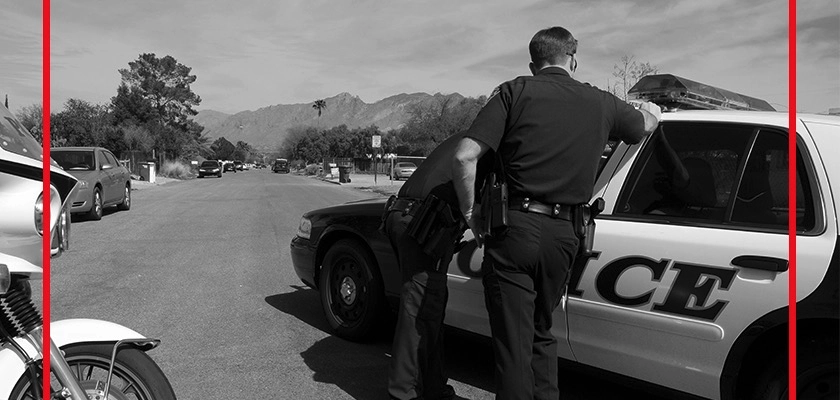"The American Tragedy: Mass Shootings and the Media Construction of Gun Violence" - Greg Lukasik, Ph.D. | July 2021
Media coverage of gun violence and mass shootings in the United States often shapes the way we view these issues. Is the impact of the media harmful or helpful?
Florida Atlantic University

After a mass shooting in Indianapolis on April 17, 2021, that left eight people dead, the media again put a spotlight on gun violence. But as Croteau et al. (2006) observe, entertainment sells better than information. As a result, even a broadcast of the evening news is indistinguishable from other forms of entertainment:
The music rises, computer-generated graphics slide across the screen, and the camera pans the “newsroom” set, settling on a perfectly coifed celebrity anchor. Showtime! This is news as entertainment and spectacle. Dramatic images of bloody victims, flaming wreckage, and somber-faced politicians fill the screen …1
The news footage covering mass shooting events typically includes dozens of police officers running to a building with weapons drawn and first responders carrying bleeding victims away from the scene. Like Hollywood action movies, these broadcasts portray the United States as a dangerous place crawling with bad guys—mass shooters, criminals, serial killers, terrorists, or lieutenants of drug cartels—all ready to kill.
But is our perception of gun violence based on the media accounts accurate, and why does it matter? Sociologists use the concept of the social construction of reality to argue that people continuously shape or construct their understanding of the world around them.2 Our perception of reality is shaped by our experiences, by other people, and by other powerful forces, including the media. Consider that while 517 people were killed in mass shootings in 2019, that number represented just 1.3 percent of 39,707 gun deaths that year.3 We hear little about the 98 percent of victims of gun violence and—to curb this problem—we should.
Of the nearly 40,000 gun deaths in the United States each year, 60 percent are suicides, and the majority of gun homicides are committed by people who know each other.4 According to the FBI’s Crime in the United States 2019 report, of 7,747 gun homicides in the United States where the relation of the victim to the perpetrator was known, more than 80 percent were committed by family members, friends, or acquaintances.5
In a democratic society, independent media is an important source of information that allows for an informed electorate. However, since the majority of the media are for-profit businesses, the profit motive often gets in a way of the public function of the media. In terms of news broadcasts, rather than providing an objective picture of reality, the goal is to attract a large audience for advertisers:
The more people watch the program, the higher the price the networks can charge for ad time. Lost audiences mean lost profits. The success of a program is largely measured in rating points among desirable demographics: those people to whom the advertisers want to speak. What sells is good.6
In the search for more profits, most major media outlets focus on the simplest and most attention-grabbing content, at the expense of a more complex, contextual analysis. Dorfman et al. (1997) found the majority of the coverage focused on violence and less than 20 percent linked the violence to broader social factors.7
By shaping how the public perceives social problems, the media also influences what types of solutions are proposed. Since gun violence is presented as a crime issue, incarceration and tougher penalties seem obvious solutions, despite evidence that these solutions are ineffective. The media rarely presents gun violence as an issue related to poverty and economic inequality, racism, or gender. The 1997 study on youth and violence found only one story out of 1,791 TV news stories with an “explicit public health frame.”8 The authors of this study concluded:
If our nation’s most popular source of news continues to report on violence primarily through crime stories isolated from their social context, the chance for widespread support for public health solutions to violence will be diminished.9
Unlike the corporate media, community activists, sociologists, and others argue that reducing gun violence requires refocusing our attention on suicide, gender socialization, poverty, racism, and the lack of opportunities in many communities. Father Greg Boyle, a Catholic priest who served for many years at Dolores Mission Church in Boyle Heights, then the poorest Catholic parish in Los Angeles that also had the highest concentration of gang activity in the city, sums up this perspective: “gang violence is about a lethal absence of hope.”10
Questions for Discussion
- What are the reasons for the media’s selective coverage of gun violence?
- Can you think of other social forces that shape our perception of gun violence in the United States?
- What is the relationship between public perception of gun violence and public policy toward gun violence?
- How is your community affected by gun violence? Does the likelihood of experiencing gun violence change depending on where you live? If yes, why?
- How do you make sense of the quote from Father Boyle who argues that gang violence results from lack of hope?
- Can selective, scripted coverage of gun violence by the corporate mass media be countered by social media, or does social media act as an “echo chamber” of the big media outlets?
References
- Croteau, David, and William Hoynes. (2006). The Business of Media: Corporate Media and the Public Interest. Thousand Oaks, CA: Pine forge Press, p.7
- Berger, P.L., and Luckman, T. (1966). The Social Construction of Reality: A Treatise in the Sociology of Knowledge. Garden City, NY: Doubleday.
- Centers for Disease Control and Prevention, National Center for Health Statistics. Underlying Cause of Death 1999-2019 on CDC WONDER Online Database, released in 2020. https://wonder.cdc.gov/controller/saved/D76/D99F025
- Gramlich, John. (2019, August 16). What the data says about gun deaths in the U.S. Pew Research Center. https://www.pewresearch.org/fact-tank/2019/08/16/what-the-data-says-about-gun-deaths-in-the-u-s/
- Department of Justice. Federal Bureau of Investigation. Crime in the United States, 2019. https://ucr.fbi.gov/crime-in-the-u.s/2019/crime-in-the-u.s.-2019/topic-pages/expanded-homicide
- Croteau, David, and William Hoyner, p.8
- Dorfman, L., Woodruff, K., Chavez, V., & Wallack, L. (1997). Youth and violence on local television news in California. American journal of public health, 87(8), 1311–1316. https://doi.org/10.2105/ajph.87.8.1311
- Ibid
- Ibid
- Our Founder Father Greg. Homeboy Industries. https://homeboyindustries.org/our-story/father-greg/



